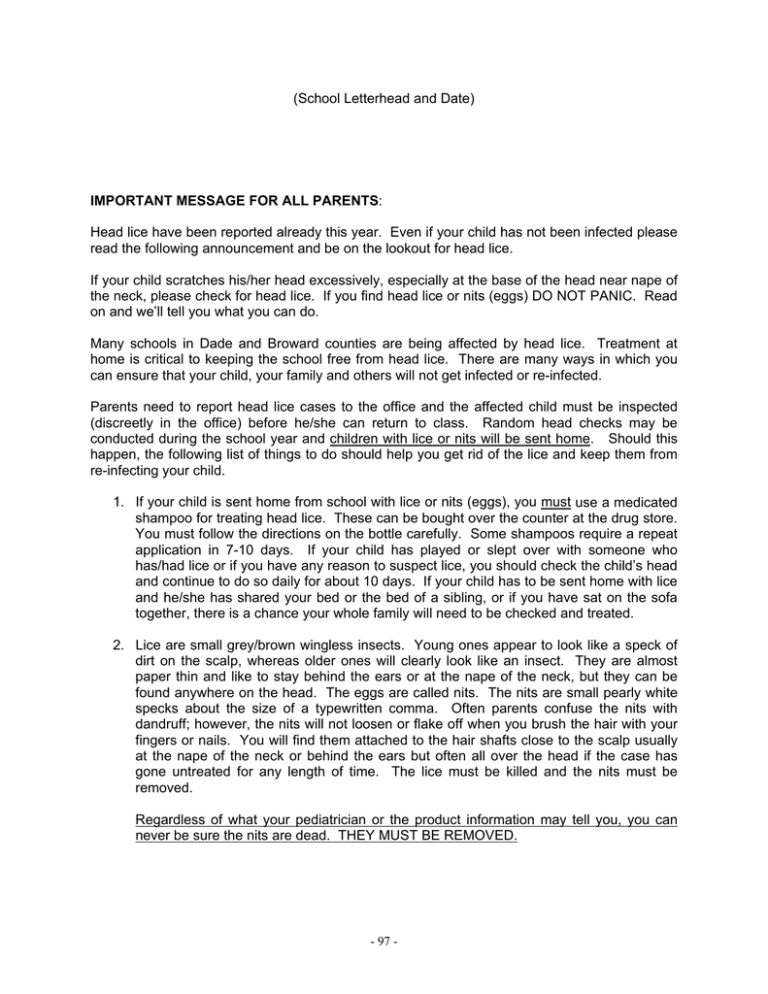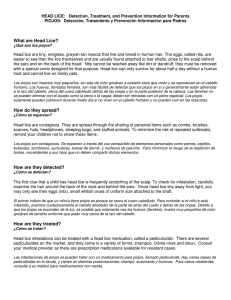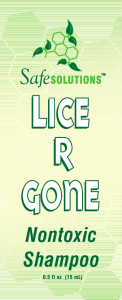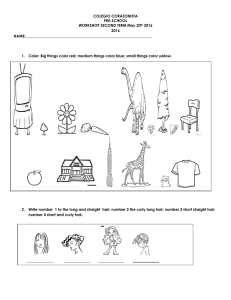Head lice have been reported already this year. Even if your ch
Anuncio

(School Letterhead and Date) IMPORTANT MESSAGE FOR ALL PARENTS: Head lice have been reported already this year. Even if your child has not been infected please read the following announcement and be on the lookout for head lice. If your child scratches his/her head excessively, especially at the base of the head near nape of the neck, please check for head lice. If you find head lice or nits (eggs) DO NOT PANIC. Read on and we’ll tell you what you can do. Many schools in Dade and Broward counties are being affected by head lice. Treatment at home is critical to keeping the school free from head lice. There are many ways in which you can ensure that your child, your family and others will not get infected or re-infected. Parents need to report head lice cases to the office and the affected child must be inspected (discreetly in the office) before he/she can return to class. Random head checks may be conducted during the school year and children with lice or nits will be sent home. Should this happen, the following list of things to do should help you get rid of the lice and keep them from re-infecting your child. 1. If your child is sent home from school with lice or nits (eggs), you must use a medicated shampoo for treating head lice. These can be bought over the counter at the drug store. You must follow the directions on the bottle carefully. Some shampoos require a repeat application in 7-10 days. If your child has played or slept over with someone who has/had lice or if you have any reason to suspect lice, you should check the child’s head and continue to do so daily for about 10 days. If your child has to be sent home with lice and he/she has shared your bed or the bed of a sibling, or if you have sat on the sofa together, there is a chance your whole family will need to be checked and treated. 2. Lice are small grey/brown wingless insects. Young ones appear to look like a speck of dirt on the scalp, whereas older ones will clearly look like an insect. They are almost paper thin and like to stay behind the ears or at the nape of the neck, but they can be found anywhere on the head. The eggs are called nits. The nits are small pearly white specks about the size of a typewritten comma. Often parents confuse the nits with dandruff; however, the nits will not loosen or flake off when you brush the hair with your fingers or nails. You will find them attached to the hair shafts close to the scalp usually at the nape of the neck or behind the ears but often all over the head if the case has gone untreated for any length of time. The lice must be killed and the nits must be removed. Regardless of what your pediatrician or the product information may tell you, you can never be sure the nits are dead. THEY MUST BE REMOVED. - 97 - 3. After using a medicated shampoo you can use the fine tooth comb that comes with most lice removal products. This will take out any remaining lice and possibly some nits. However, most nits will have to be removed by hand (or with tweezers). Blow dry the hair. Then in strong light separate the hair into small sections with the fingers and look for nits. A lighted magnifier works really well. It’s often easiest to see the nits outdoors in sunlight. Pull them off with fingernails or a pair of tweezers starting at the scalp and pulling down the hair shaft, one hair at a time until all nits are removed. Some hair types make it extremely difficult to remove nits. If you have a problem with this you can try wetting the hair and pouring a solution of half vinegar and half water through it. Wrap the child’s head in a towel for 20 minutes. Rinse well and remove nits while hair is wet. The vinegar/water solution may loosen the nits and make it easier to remove them. The vinegar/water rinse can be repeated if necessary. There are now lice egg remover solutions on the market that help loosen the nits. 4. Nits are like weeds – just when you think you’ve got them all, another one shows up! Because of this you must check your child’s head several times after treatment and daily for about 10 days. If you don’t do this, one nit could hatch and start the process all over. Also, continue to blow dry the affected person’s head occasionally during this time. Check all family members’ heads during this 10 day period as well. 5. You must follow these directions for home and car: a) Wash or disinfect every article that may have been infected, i.e. brushes, combs, barrettes, ponytail holders, hats, and the places where they are kept. b) Sheets, blankets, quilts, bedspreads, pillow cases, pillows, towels, clothing (including underwear and sleepwear) must be washed in hot (130 degree) water and dried in a hot dryer for at least 20 minutes. c) Furniture, rugs, floors and baseboards, hampers, headboards and mattresses must be thoroughly vacuumed. The vacuum bag must be disposed of in a sealed plastic bag. d) Treat your car – vacuum carpet and seats. e) Dry clean items that can’t be washed or place them in a hot dryer for 20 minutes (i.e. stuffed animals and pillows) or place in an airtight plastic bag for 10 days. f) Use rubbing alcohol or over the counter germicide to wipe off phones, headsets, helmets or any other item that may have come into contact with the child’s head. g) notify the school (if your child was not sent home), carpool, Sunday School or anyone who has had close contact with your child. Don’t be embarrassed. Head lice can affect any person regardless of race or gender and does not denote lack of cleanliness. They are found all over the country, but they are the biggest problem in warm climates. In order to rid the school of head lice, these procedures must be followed at home. The Principal and staff are doing everything they can to ensure a lice free environment. It’s really up to the parents to keep infected children from bringing the lice back to school. If you have any questions, please call the school at (telephone number of school). Sincerely yours, (Principal’s Signature) - 98 - (School Letterhead and Date) MENSAJE IMPORTANTE PARA LOS PADRES DE FAMILIA: Este año ya se han reportado algunos casos de piojos en el cabello. Aunque su hijo/a no esté infectado, por favor, lean cuidadosamente la información a continuación y manténganse vigilantes en cuanto a los piojos. Si su hijo/a se rasca la cabeza excesivamente, especialmente en la zona de la base del cabello o el cuello, por favor, revísenlo para ver si tiene piojos en el cabello. Si encuentran piojos o huevos de piojos, NO SE ALARMEN. Sigan leyendo y les explicaremos qué pueden hacer para remediarlo. Muchas escuelas de los condados Dade y Broward han sido afectadas por los piojos en el cabello. El tratamiento en el hogar es decisivo para mantener a las escuelas libres de estas plagas. Hay muchas formas en las que ustedes pueden asegurar que su hijo/a y su familia no se infecten o re-infecten. Los padres de familia deben reportar cualquier caso de infección de piojos en el cabello de sus hijos a la oficina de la escuela y el niño/a afectado deberá de ser inspeccionado (discretamente en la oficina de la escuela) antes de que se le permita regresar a su aula. Muchas veces se conducen revisiones al azar durante el año y los niños que tengan piojos o huevos en el cabello serán enviados a sus hogares. En caso de que esto ocurra, la siguiente lista le informará de los pasos que pueden tomar para eliminar los piojos y para que su hijo/a no se re-infecte. 1. Si la escuela envía a su hijo/a a la casa porque tiene piojos o huevos de piojos en el cabello, ustedes deberán usar un champú medicado para el tratamiento de los piojos en el cabello. Estos champuses se pueden comprar sin receta médica en cualquier farmacia. Ustedes deberán seguir muy cuidadosamente las instrucciones que aparecen en el envase del champú. Algunos champuses requieren una segunda aplicación al cabo de los 7 a 10 días. Si su hijo/a ha jugado o dormido en la casa de alguien que tiene o ha tenido piojos o si ustedes sospechan, por alguna razón, que hay infección de piojos, inmediatamente ustedes deberán revisar la cabeza de su hijo/a y continuar las revisiones por un período de 10 días. Si su hijo/a es enviado a la casa porque le han encontrado piojos y ha compartido la cama con usted o algún hermano o se han sentado juntos en el sofá, existe la posibilidad de que su familia completa tenga que ser revisada y tratada con el champú para piojos. - 99 - 2. Los piojos son diminutos insectos sin alas de color gris/marrón. Los más jóvenes aparentan ser una manchita de polvo en el cuero cabelludo, en tanto que los más viejos claramente se reconocen como insectos. Son casi transparentes y les gusta quedarse detrás de los oídos o en la parte de atrás del cuello, pero también pueden encontrarse en cualquier parte de la cabeza. Los huevos son unas diminutas manchitas de color blanco perlado, del tamaño de una coma escrita con una maquina de escribir. Muchas veces estos huevitos pueden confundirse con la caspa, la diferencia es que los huevos no se aflojan o caen fácilmente cuando se peina el cabello con los dedos o uñas, como pasa con la caspa. Los huevos se encuentran pegados al cabello cerca de la raíz, casi siempre cerca de la parte de atrás del cuello, detrás de los oídos o, a menudo, también en toda la cabeza, especialmente si la infección no ha sido tratada por un largo tiempo. Hay que matar los piojos y sus huevos deben ser removidos. Aunque su pediatra o la información que aparece en el envase del producto digan lo contrario, la única forma de cerciorarse de que los huevos están muertos, ES QUITÁNDOLOS del cabello. 3. Después de usar un champú medicado, pueden usar el peine de dientes finos que casi siempre viene con los productos que se usan para matar los piojos. Este peine quitará cualquier piojo que todavía permanezca en el cabello, como también sus huevos. Sin embargo, la mayoría de los huevos tendrán que ser quitados con la mano o con unas pinzas. Sequen el cabello con un secador de pelo. Bajo una luz intensa, separen el cabello en pequeñas secciones con los dedos y busque los huevos. Una lámpara con lupa les será muy útil, pero a veces es más fácil ver los huevos fuera de la casa, a la luz del sol. Quiten los huevos con las uñas o con un par de pinzas comenzando en la raíz del cabello y halando hasta el final del cabello, pelo por pelo, hasta que todos los huevos hayan desaparecido. Se hace muy difícil quitar los huevos en ciertos tipos de cabello. Si a ustedes se les dificulta quitar los huevos por esta razón, mojen el pelo con una mezcla mitad vinagre y mitad agua. Envuelvan una toalla alrededor del cabello del niño/a por 20 minutos. Enjuaguen bien el cabello y quiten los huevos mientras el pelo esté mojado. La mezcla de vinagre y agua afloja los huevos, permitiendo que se remuevan más fácilmente. El enjuague de vinagre con agua puede repetirse si es necesario. Ahora hay enjuagues que ayudan a aflojar los huevos en el mercado. 4. ¡Los huevos se comportan como las yerbas malas – precisamente cuando uno piensa que los ha quitado todos, aparece uno! Debido a esto, ustedes deben revisar el cabello de su hijo/a varias veces después del tratamiento. De no hacer esto, uno de los huevos puede incubar e iniciar el proceso una vez más. Continúen secando el pelo del niño/a afectado con un secador de pelo - 100 - HEAD LICE (PEDICULOSIS CAPITIS) DESCRIPTION: SIGNS AND SYMPTOMS: INCUBATION PERIOD: MODE OF TRANSMISSION: PERIOD OF COMMUNICABILITY: PREVENTION: IMPLICATIONS FOR SCHOOLS: Lice are light gray insects that lay eggs or “nit” in hair, especially at the nape of the neck and about the ears. The life cycle of the head louse has three stages: egg, nymph, and adult Early signs may be itching caused by the bite of the louse (insect) and red bite marks and scratch marks may be observed on the scalp and neck. The presence of nits (eggs) attached to the hair shaft close to the scalp may exist in the absence of itching. The incubation period from laying eggs to hatching of the first nymph is 6 to 10 days. Mature adult lice capable of reproducing do not appear until 2 to 3 weeks later. Lice spread only when they crawl from person to person directly or when they crawl onto shared personal items; i.e., combs brushes, hats, bedding, etc. A person is infectious as long as lice or nits remain on their head or clothing. Contact the Department of Comprehensive Health Services for information on prevention (305-995-1235). Exclude any students with lice or nits until satisfactorily treated and there are NO NITS found in the hair. - 70 - Miami-Dade County Health Department – School Health Program A Guide for the Prevention & Treatment of Head Lice* “Check your child’s homework; check your child’s hair” Anyone – child or adult – can get head lice. Head lice are passed from person to person by direct contact, or by sharing objects (combs, towels, headphone, hats, etc.). Getting lice has nothing to do with cleanliness and having lice does not reflect poorly on you as a parent. The problem can be easily managed. Just follow the directions below: 1. WHAT TO LOOK FOR... Head lice are small grayish-tan crawling insects about the size of a sesame seed. Look for tiny eggs (nits) on hair shafts, near the scalp, and especially at the nape of the neck and behind the ears. Any family member with lice or nits must be treated. 2. HEAD LICE TREATMENT… Several products are available without a prescription; most require a second application 7-10 days after the first. Read and follow the product information carefully. Consult with your physician or pharmacist for more information. 3. HEAD LICE – DEAD LICE Remove all lice and nits (eggs) using a special nit comb, or your fingernails. Look at the hair outdoors in sunlight (a magnifying glass maybe helpful). Research shows that you must comb and check hair for nits EVERYDAY UP TO 14 DAYS TO STOP THE LIFE CYCLE OF THE LOUSE. Miami-Dade County Public Schools has a no nit policy. Even if you have treated your child’s head with shampoo, but nits are found in their hair when returning to school, the child will be excluded from school. REMEMBER: If your child gets lice over and over, you probably haven’t removed all the eggs. Remaining eggs can hatch and cause a re-infestation. The best treatment is the COMPLETE removal of lice and nits. 4. WASH & DRY… Use hot water and dry on hot cycle for at least 20 minutes. Items that are not washable should be vacuumed (stuffed animals, helmets, headsets, etc.) - 94 - 5. SOAK … Combs, brushes, etc. the hotter the better, but at least 130 degrees F. for at least 10 minutes. 6. VACUUM EVERYWHERE… To make sure the rest of you home is lice free, you should vacuum carpets, pillows, mattresses, upholstered furniture and even car seats. Avoid the use of lice sprays. 7. FACTS & TIPS TO REMEMBER… Lice prefer to stay in the hair, not the environment. Lice cannot stay alive in schools or school buses on the weekends, because they cannot live without human contact for more than 48 hours. Kids might get head lice at sleepovers, while at group or club activities, family gatherings, babysitting, playing sports, watching TV or playing video games together. According to national research, lice appear more prevalent after school breaks because lice are a community problem, and children have more close contact with each other during breaks. Head lice are spread if two heads are together. Lice cannot jump or fly. The color of the louse depends on when it had its last blood meal. Pets do not get head lice. Head lice can happen to anyone. REMEMBER: SCHOOLS DON’T GET LICE, PEOPLE DO. FOR MORE HELP: 1. National Pediculosis Association www.headlice.org 2. Center for Disease Control (CDC) www.cdc.gov *Pasco County School District “Nice People Get Lice” - 95 -



